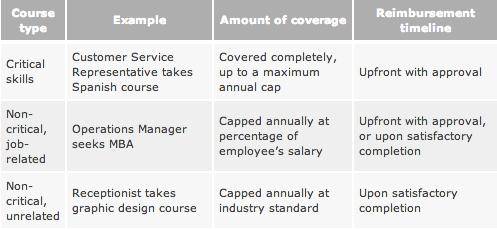A robust employee training and development program can help a company boost engagement, performance, and retention. While programs vary from one organization to the next, however, their success is largely dependent on business leaders’ ability to manage investments in employee education in a way that maximizes returns–both for the employer and the employee.
One way to accomplish this is by supporting employees’ education and development—and tying personal goals to company goals. In fact, many companies have specific programs that provide assistance for costs for continued education. For these tuition assistance programs (or TAPs) to be successful, though, they must encourage the development of specific skills in your workforce, while empowering employees to pursue their educational goals.
For companies who want to launch a new TAP—or revamp an existing one—it’s hard to know where to begin. To that end, I connected with John Zappa, CEO of EdLink to identify a few key steps to get you started.
1. Identify Goals, Support with Investments
Work with your senior management team to set quantifiable, measurable goals. Address the question of cost early on, using your goals as a guiding compass. The more critical a goal, the larger your investment in a TAP. Alternatively, you can follow industry standards for less-than-critical goals.
You might consider breaking qualifying coursework into groups. Here is an example:
2. Establish Guidelines, Communicate Expectations and Opportunities
Clear guidelines and qualifications will help to ensure a TAP supports your business goals. As such, they should address what skills are valuable to the employer, and why. Make it easy for employees to understand your business needs and how to make education choices that support those needs. Talk to employees about your tuition program in the onboarding process and periodically hold Q&A sessions to bolster interest and adoption.
3. Balance Guidelines with Flexibility and Opportunity
While guidelines are important, offering employees an opportunity to pursue their personal goals is also important. By being flexible, and offering assistance for four-year degrees, continuous learning, and applied learning coursework, employees can pursue educational goals in whatever time frame suits their needs.
Furthermore, courses unrelated to an employee’s current position shouldn’t be outright excluded. These provide opportunities for employees to acquire new skills and knowledge beyond the boundaries of their current role. This can improve employee satisfaction (which aids in retention) and create more rounded employees.
4. Measure Program Outcomes, Adjust Accordingly
For your program to have the greatest impact (and lasting success), it should be treated as an investment in a larger talent management strategy. To that end, measuring program outcomes — and how they affect other business initiatives — is essential.
Track changes in retention and engagement, and compare data against nonparticipants. And cross reference this data with things like customer satisfaction or changes in sales numbers for hard data on the value of the program.
If the program is driving desired outcomes, consider allocating more resources to allow more employees to participate. If not, survey employees to identify the reasons. Were guidelines and qualifications too rigid? Was course completion an issue? Were work schedules an obstacle?
Effective TAPs are Smart—Not All-Encompassing
Investing in employee education is a great way to foster higher retention rates and improve employee performance, but at the end of the day you’re working with limited resources. Whether you’re creating a new TAP or revamping an old one, remember that an effective plan doesn’t have to be a large plan. It has to be smart. By matching company needs with employee goals, you can encourage workforce learning without a big budget. That beings with business strategy and proactive program management. The rest is up to your employees.

 We are extremely pleased to announce that Dresser & Associates has joined Net@Work, one of the most respected Sage Software Partners in North America and an award-winning end-to-end technology solutions provider. You will see very little change relative to your Sage Software support, really just a name change.
We are extremely pleased to announce that Dresser & Associates has joined Net@Work, one of the most respected Sage Software Partners in North America and an award-winning end-to-end technology solutions provider. You will see very little change relative to your Sage Software support, really just a name change.










